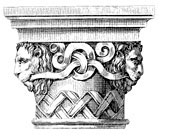
The Language of the Body & the Mass
AT THE NAME OF JESUS, LET EVERY KNEE REMAIN UNBENT?
The rhythms of our worship become part of us; sacred actions long practiced become second nature. Catholics at Mass sit to hear the homily and rise together to recite the Creed and to pray the General Intercessions. They sit again while the collection basket goes round and while the priest blesses the gifts of bread and wine. Then, to the priest’s exhortation “Pray that our sacrifice may be acceptable” they reply “May the Lord accept the sacrifice at your hands,” and all rise together for the prayers that culminate in the communal recitation or singing of the Sanctus, which ends with “Blessed is he who comes in the name of the Lord, Hosanna in the highest!”
And then — and then what happens? According to the rubrics published by the American bishops, according to immemorial custom, according to the instructions in the missalette in the pew, we kneel. But this Sunday you are not at your home parish, and as your knees begin to bend, you hesitate, noticing that many people are still standing. Have you mistaken the moment, rapt as you are in a mystic reverie — or daydreaming? Isn’t this the Eucharistic Prayer and Consecration? Don’t we kneel now? You kneel uncertainly, distracted by an uneasy need to survey your fellow worshipers: Almost all of them are standing. If you continue kneeling, your view of the altar will be blocked and you risk sidelong glances from those towering over you. You surreptitiously check the missalette: Yes, it says “Kneel.”
What’s going on?
Up, Up and We Pray
The liturgical norm in the U.S., according to custom and clear directives from the bishops, is that the congregation at Mass should kneel between the Sanctus and the Lord’s Prayer, that is, during the entire Eucharistic Prayer. But some liturgists have been arguing that this is incorrect, that “Catholics Should Stand at the Consecration” (as D. Phillipart wrote in U.S. Catholic in July 1993). Kneeling, he said, is a penitential posture, and “is like mourning on Easter….” Erasto Fernandez, writing in Emmanuel (100:293), opines that the standing posture is “the expression of the holy freedom of the children of God acquired at Baptism.” Fernandez states, citing Deuteronomy 18:3-5, that “for community or liturgical prayer, the common posture is standing, sometimes with the arms extended.” He allows that “it is customary to kneel during the recitation of the institution narrative [the Consecration]…out of deep respect for the central action.” But he insists that one could also “remain standing.” Phillipart would restrict kneeling to penitential times, private prayer, and extraliturgical devotions. If Christ is present in all the Mass, “why kneel at the Consecration?”
You May Also Enjoy
A Carmelite monastery in Wyoming is an exciting new element in the Church in America, and has proven to be fecund ground for vocations to the consecrated life.
Why do Catholics (and Jews) reject prostration as a regular posture of liturgical worship, and why do Muslims use it as the signature posture of daily salat?
We ought to be thankful to Pope John Paul II, who set the stage for this momentous improvement of the Mass in the vernacular.

